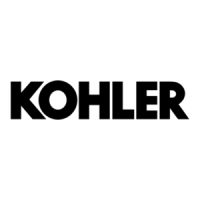TP-5737 5/016 Section 2 Operation
2.3 Prestart Checklist
To ensure continued satisfactory operation perform the
following checks or inspections before or at each
startup, as designated, and at the intervals specified in
the service schedule. In addition, some checks require
verification after the unit starts.
Air Cleaner. Check for a clean and installed air cleaner
element to prevent unfiltered air from entering the
engine.
Air Inlets. Check for clean and unobstructed air inlets.
Air Shrouding. Check for securely installed and
positioned air shrouding.
Battery. Check for tight battery connections. Consult
the battery manufacturer’s instructions regarding
battery care and maintenance.
Coolant Level. Check the coolant level according to
the cooling system maintenance information.
Drive Belts. Check the belt condition and tension of the
water pump and battery charging alternator belt(s).
Exhaust System. Check for exhaust leaks and
blockages. Check the silencer and piping condition and
check for tight exhaust system connections.
Inspect the exhaust system components (exhaust
manifold, mixing elbow, exhaust line, hose clamps,
silencer, and exhaust outlet) for cracks, leaks, and
corrosion.
D Check the hoses for softness, cracks, leaks, or dents.
Replace the hoses as needed.
D Check for corroded or broken metal parts and replace
them as needed.
D Check for loose, corroded, or missing clamps.
Tighten or replace the hose clamps as needed.
D Check that the exhaust outlet is unobstructed.
D Visually inspect for exhaust leaks (blowby). Check
for carbon or soot residue on exhaust components.
Carbon and soot residue indicates an exhaust leak.
Seal leaks as needed.
D Ensure that the carbon monoxide detector is (1) in the
craft, (2) functional, and (3) energized whenever the
generator set operates.
Fuel L evel. Check the fuel level and keep the tank(s)
full to ensure adequate fuel supply.
Oil Level. Maintain the oil level at or near, not over, the
full mark on the dipstick.
Operating Area. Check for obstructions that could
block the flow of cooling air. Keep the air intake area
clean. Do not leave rags, tools, or debris on or near the
generator set.
Seawater Pump Priming. Prime the seawater pump
before initial startup. To prime the pump: (1) close the
seacock, (2) remove the hose from the water-filter
outlet, (3) fill the hose and seawater pump with clean
water, (4) reconnect the hose to the water filter outlet,
and (5) open the seacock. Confirm sea water pump
operation on startup as indicated by water discharge
from the exhaust outlet.
2.4 Marine Inspection
Kohler Co. recommends that all boat owners have their
vessels—especially the exhaust system attached to the
generator set—inspected at the start of each boating
season by the local Coast Guard Auxiliary. If there is no
Coast Guard Auxiliary in the area, contact an authorized
Kohler distributor/dealer for the inspection.
m:op:001:003
2.5 Angular Operation
See Figure 2-2 for angular operation limits for units
covered in this manual.
Continuous
Intermittent—
3 minutes or less
25_ 30_
Maximum value for all directions
Figure 2 -2 Angular Operation
m:op:001:004
2.6 Exercising the Generator Set
Operate the generator set under load once each week
for one hour with an operator present.
The operator should perform all of the prestart checks
before starting the exercise procedure. Start the
generator set according to the s tarting procedure in the
controller section of this manual. While the generator
set is operating, listen for a smooth-running engine and
visually inspect the generator set for fluid or exhaust
leaks.
x:op:001:005

